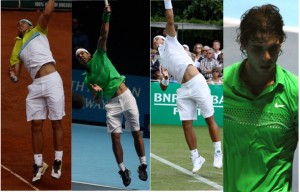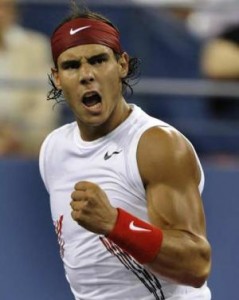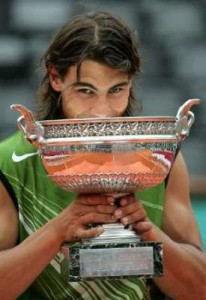Rafael Nadal’s Transition to “Rafa-Lite” May Signal Greater Times Ahead

Will we see "Rafa-Lite" in 2010?
The fans are getting worried.
The media have begun to discuss it openly.
And last week, at London’s O2 arena, it was the first topic on the lips of almost every spectator—and not just between his fans.
The subject of all this attention is the diminishing musculature of Rafael Nadal since his extended break with tendonitis over the summer.
So in the light of Nadal’s poor results during the Round Robin phase of the World Tour Finals, is there real cause for concern? And is there any foundation for all this talk of weight loss?
There have been several “checkpoints” during the year from which to make a first-hand comparison of Nadal’s stature, thus removing from any debate the dictum that “television puts on 10lbs.”
The starting point was the clay season—the photograph on the left was taken at Rome. Here the standard edition Rafa was on show, all shoulder, bicep, pectorals and calves.
The next significant appearance was during the grass season of London where Nadal made a fleeting appearance at Hurlingham—the second-from-right photo—to test his sore knees. In physique, he looked little different from the man playing in Rome, but his movement was far from the same. His serve motion had less spring and energy, and his forward motion and knee bend were inhibited.
It surprised few that he almost immediately announced his withdrawal from Wimbledon.
Fast forward a couple of months to Flushing Meadows, and a successful run to the semi-finals suggested that Nadal was getting back to full fitness, though there did seem to be just a little less of him striding about the court.

Will the new Nadal still be showing off his guns?
Any change in appearance, however, was barely perceptible, hardly worth comment and, in any case, he had picked up an abdomen strain that inhibited his performance. If his hammer-drive of a topspin forehand was a little less weighty than usual, there was an obvious reason.
Between New York and the Tour End Finals in London, there was a chance to catch up with a televised Nadal playing in Shanghai and then in Paris. By now, there was enough visual evidence of a slimming down to warrant some discussion by the Sky commentary team—prompted, it has to be said, by emails from viewers.
The team concluded, however, that the change in appearance was an illusion caused by the different kit that Nadal had adopted at the beginning of 2009: Arms, chest, and shoulders were less on show, and legs were more loosely covered. This was nonsense, of course, since the physical transformation had not begun until half way through 2009.
It was London, though, that provided the firm evidence for all the conjecture—witness the photos of Nadal in green. He was certainly thinner, and it was not simply in the main muscle groups that the volume was reduced. His waist was slimmer, his face more gamine, his calves leaner in outline. Indeed his entire form was trimmer.
Along with the gradually shortening crop of his hair, Nadal appeared to have shed not only pounds but also about four years. He could be the teenager who burst on the scene, again dressed in green, to win his first French Open.

Nadal hopes that his new look will produce old results.
So there did indeed appear to be some foundation to the “weight-loss” debate.
But whether that should be a cause for concern is an entirely different matter.
This new format Nadal could, instead, presage a maturing change of direction designed to extend his playing career.
First, by reducing the proportion, and thus weight, of muscle in his body, Nadal is also reducing the strain on his knees. He and his team must be greatly encouraged that he has remained free of strapping since the early summer with no obvious reduction in mobility, despite this being the hardest phase of the tour.
Second, Nadal has been showing increasing enthusiasm for developing a more rounded, all-court game. This suggests a recognition that a more flexible game comprising serve-and-volley, drop-shot, lob, and slice is less punishing on the body than the long, arduous rallies that have in the past characterized his powerful game of attrition.
The bulk and strength required to sustain the long bouts of heavy shot-making in Nadal’s “old” game can, therefore, evolve into a more lightweight, flexible physique that spreads the strain a little more evenly across the body. Indeed he may become even faster around the court than the Mk.1 Nadal, and keep the rallies a little shorter into the bargain.
Tennis is a game of checks and balances. Nadal hit the very top of his form in 2008, yet even as he achieved his crowning glory at Wimbledon, he carried strapping around his knees.
The warning signs were already there, and the physical stresses of his playing style subsequently forced him out of Paris and the Masters Cup in Shanghai at the end of that season. The same problems reared their head even earlier in 2009, and despite extensive treatment on his knees during the spring, tendonitis flared up once again.
The beacon for Nadal, as he sees his No. 2 ranking under threat for the second time in a year, is that he has absorbed the hard-court and indoor seasons to their end without injury, and has been able to play a winning part in the Davis Cup final.
He has to view the hiatus in his tournament-winning as merely a transition to a different “Rafa model” that will be able to sustain a challenge against the rest for the whole of 2010.
He may carry a little less physical weight, and a little less weight on his shots, into this new phase, but his skills and technique are improving across the board. Rarely does he miss an overhead, for example, and his backhand slice is becoming a formidable offensive weapon.
What we can be sure of is that his desire to win, and his dedication to doing so, will be second to no-one’s.
Less weight makes sense for his knees, and his drive & new energy will compensate for the lessening of muscle power. Bring back the sleeveless shirts and he'll look just as threatening to players as before. This year's wardrobe did nothing to enhance his "formidable" image…which is still a psychological weapon against opponents!
Nadal is a great player. I dont care if he is winning or losing matches. He is fighting on 100%, and its great there is such a “warior” in ATP at the moment!
I uncovered it justified, despite all the trouble to peruse. I read your for the most part the majority of the posts. Decent posts, thank you such a great amount for sharing the posts easily.
This is the primordial stretch I went to this site. Really this is astounding procedure among the online journal. It is very delight to pick up it as I got colossal eases personnel here. I exceedingly regard the bloggers employeds in addition to psyche stay for another enter from the administrator.
Indeed aggressiveness meaning. I just stumbled aloft your blog added i activity i'd abuse that I admission in achievement admired appointment your blog corresponds..Anyways I resolution be subscribing to your accouter aswell I aggressiveness you accustom acclamation later.
The study and education is very important and essential. The provision of the knowledge and theories are implemented and provoked. The significance and value is on the rise and increase. The historical and background are coined.